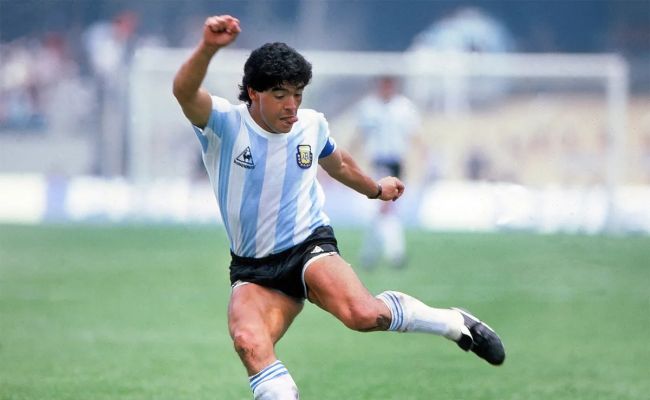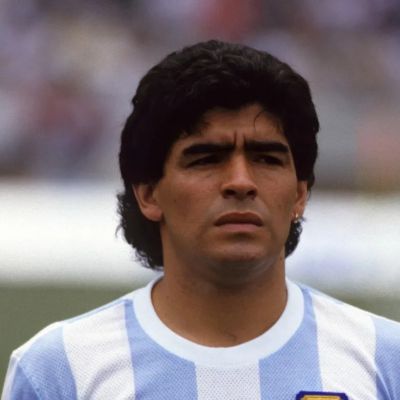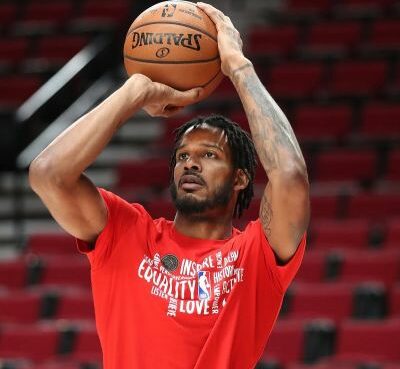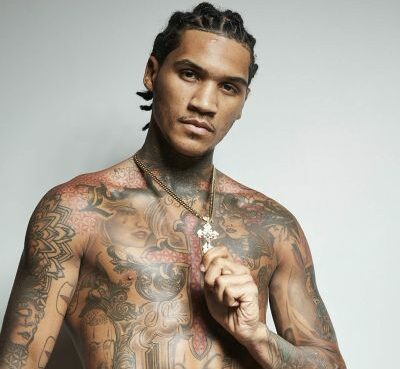Table of Contents
Who is Diego Maradona?
Diego Maradona was a well-known Argentine football coach, manager, and professional soccer player. Diego Maradona was one of the highest-paid athletes in the world in the early 1980s, receiving several million dollars a year in pay and endorsements from businesses like Hublot, Puma, and Coca-Cola.
Maradona made his professional debut for the Argentinos Juniors and became the sole breadwinner for his low-income family at the age of 15.
Birth
Diego Maradona was born on 30 October 1960, in the city of Buenos Aires, Argentina.
Facts of Diego Maradona
| Full Name | Diego Armando Maradona Franco |
| Date of Birth | 30 October 1960 (Sunday) |
| Birth Place | Lanus, Buenos Aires, Argentina |
| Nick Name | Hand Of God & The Golden Boy |
| Religion | Christianity |
| Nationality | Argentine |
| Ethnicity | Argentinian |
| Zodiac Sign | Scorpio |
| Age | 60 years old |
| Height | 1.65 m (5’5″) |
| Weight | 155 lb (70 kg) |
| Hair Color | Black |
| Eye Color | Black |
| Food Habit | Non-Vegetarian |
| Father’s Name | Diego Maradona Senior |
| Mother’s Name | Dalma Salvadora Franco |
| Siblings | Brothers: Hugo Maradona & Raul Maradona Sisters: Ana Maria Maradona, Rita Maradona, Maria Rosa Maradona & Elsa Maradona |
| Marital Status | Divorced |
| Wife | Claudia Villafane (1984-2003) |
| Kids | Sons- Diego Maradona Junior & Diego Fernando Maradona Daughters- Dalma Maradona, Gianinna Maradona & Jana Maradona |
| Affairs/ Girlfriends | Lucia Galan (1981-1982) Cristiana Sinagra (1985) Veronica Ojeda (2013) Rocio Oliva (2014) |
| Profession | Professional Footballer |
| Position | Attacking Midfielder |
| Debut | Club- 1976 International- 1977 |
| Jersey Number | 10 |
| Retirement | 1997 |
| Favorite Food | Pizza, Pasta, and Cakes |
| Net Worth | $100 Thousand (Approx.) |
| Social Media | |
| Date of death | November 25, 2020 (Wednesday) |
| Place of death | Buenos Aires, Argentina |
| Cause of death | Heart Attack |
| Merch | Diego Maradona, Maradona: The Autobiography, Retro Jersey |
Net Worth and Earnings
According to estimates, Diego Maradona is worth $100,000 (£75,000). He had a 20-year career with Barcelona, Napoli, and Boca Juniors, where he practiced his craft.
From the start, the well-known footballer drew a large sum of money. On the field, he was an absolute superstar, and nothing could stand in his way.
Puma has been a strong supporter of him since his early days and has a positive relationship with the German titans to this day.
Similarly, endorsements with Coca-Cola, Hublot, and a few other companies helped him ascend the financial ladder. At one point, his worth was believed to be around 50 million Euros.
Regrettably, his holdings were seized by the Italian tax authorities, and he was forced to pay enormous sums of money—currently estimated at 90,000 Euros.
Maradona’s salary as manager of Gimnasia de La Plata, which was likewise a temporary contract until the end of the 2019-20 season, remains unknown.
The former Argentine manager was paid $150,000 (£118k) a month as Dorados’s head coach, equating to $1.6 million (£1.25 million) for the course of his 11-month contract.
He was FIFA’s ambassador to the 2018 World Cup in Russia before becoming a Dorados manager. He’d also agreed to lead Belarus’ Dinamo Brest for three years.
He did, however, work in Belarus for a short time after relocating to Mexico.
Automobiles
People have long been envious of celebrities’ luxurious lifestyles.
In addition to Golden Balls and other sporting trophies, Maradona had an outstanding collection of outside automobiles, including his first Porsche 924, a black Testarossa BMW i8, and a Rolls-Royce Ghost, all of which were placed for sale at JamesEdition in 2010.
Porshe 924 was designed in Germany and shipped to Argentina in 1979 at the request of a 19-year-old soccer player.
This car, which featured a 125 horsepower engine and a mileage of little under 40,000 miles (64,374 kilometers), was put on the market in 2010 for $500,000.
Its market value increased to $112,928 by 2020.
Maradona purchased the black Testarossa in 1987 when Ferraris were only available in red.
After Silvester Stallone and Michel Jackson, the footballer became Ferrari’s third customer to park the black Testarossa in his garage.
Only two of these vehicles (made in 1988 and 1990) are now available for purchase at JamesEdition, with prices ranging from $112,000 to $159,000.
The vehicle was one of Maradona’s most recent purchases, which he made while training in the United Arab Emirates.
One of Maradona’s most frequently used automobiles in recent years, the Rolls-Royce Ghost, was apparently included in his estimated $90 million estates.
House
The property was purchased by Maradona as part of his initial contract with the Argentinos Junior in 1978.
The two-story mansion has been turned into a museum so that admirers may learn more about the icon’s early years.
The “Maradona ‘House of God’ museum,” currently known as the “Maradona ‘House of God’ museum,” opened to the public in 2016. Alberto Perez, the former manager of the Argentinos, paid £82,000 for the residence.
Maradona’s personality and style of life appeared to be beyond his means. When he stopped playing, things got even worse.
Maradona’s post-retirement years were dominated by claims and exorbitant costs, thanks to several lovers and illegitimate offspring, as well as a $50 million tax obligation owed to the Italian authorities.
He has luckily survived due to his immense stature and popularity in Argentina. And the UAE’s or South America’s strong support, which includes Fidel Castro.
Diego Armando Maradona, who passed away at the age of 60, was regarded as a football god. His manner of life, however, with his addiction demons, had crushed him.
Charity
Maradona isn’t recognized for his humanitarian efforts. However, he has volunteered for a number of charitable organizations, including UNICEF.
In 2010, he participated in a shootout game hosted by one of their sponsors, Hublot, to help fund $500,000 for a children’s charity.
Films, investments, endorsements, and book releases
It’s impossible to deny that Diego Maradona had a difficult existence as he grew older. In his grandeur, though, he received $8 to $10 million in approval.
However, Maradona’s great business authority was jeopardized as a result of conflicts with other unscrupulous consultants.
Many companies, on the other hand, wanted to be linked with the important intellectuals or groups for whom they had performed.
These firms became famous around the world because of their branding on Maradona’s proud chest or magical feet.
There’s a funny story about the 1986 Argentine jersey worn by Mexico. To avoid color clashes with the opposing team, the teams have two uniforms in the tournament, one light, and one dark.
Argentina had a dark blue jersey in addition to their regular blue and white blue line.
The team also wore it to their famous quarter-final match against England, where Maradona scored a Hand of God goal and a top-class solo just four minutes later.
However, in his book “Touched by God: How We Won Mexico 86 World Cup,” Maradona stated that the team most likely did not have any other shirts ready for the match.
Puma X Maradona
Puma was one of the pillars of Maradona. For most of his career, he wore their issues.
The brand finally unveiled a shoe dedicated to Maradona, calling it the King Maradona Super.
One of the company’s earliest ads shows a young Maradona saying, “Puma es mi major amigo,” which translates to “Puma is my best friend.”
After a break of a few years, Puma and Maradona reportedly signed a lifelong contract. Not to mention, Maradona was often spotted wearing Puma clothes.
Coca-cola
Before aerated drinks became known for their adverse health effects, a significant cola contract was almost as desirable to athletes as a water-based tarot contract.
Maradona had one of the biggest, Coca-Cola ‘A Coca Cola pour a sour’, which means Coca-Cola smile. During his early days, the Argentine star promoted the brand.
About a decade ago, Maradona traveled to India to introduce a jewelry brand from Kerala businessman Boby Chemmanur.
Career
At the tender age of 15, Maradona made his professional debut for the Argentinos Juniors and became the sole breadwinner for his low-income family.
Immediately impressive at the national level, the Boca Juniors bought him in 1981 for $4 million.
Likewise, he spent only one year with the team he supported at a young age before moving to Barcelona in 1982 after a failed World Cup campaign.
When Diego arrived in Barcelona, there were high expectations. A team paid a record fee of $7.6 million to sign the young star.
Although Maradona is popular with Spanish fans and continued to do well in the team, his stay in Catalan city was marred by numerous controversial incidents.

In 1984, a hot exchange saw Diego attack several Athletic Bilbao players. And he had knocked one of them down with his knees.
The altercation leads to a riot inside the stadium, with Maradona being sacked by FC Barcelona.
Napoli broke the transfer fee set by Diego earlier, paying nearly $10.5 million to Argentina. It was here that Diego had reached the top.
Leading the team to two titles, including for the first time in history during their particular gold seasons.
World Cup
During this time, Diego helped Argentina win the 1986 World Cup. He smashed the ball with his hand to score points against England in a 2-1 battle.
Maradona denied it on handball when asked about it, instead suggesting it as a “God’s hand.”
And this statement has been one of the most repeated in the history of football.
At one point, his private life in the game caused a steep decline in his career. Ergo, the 1990 World Cup was a disappointment for both, Maradona and the Argentine team.
In 1992, he forcefully left Napoli after discovering he had had cocaine. Unfortunately, in 1994, he was thrown out of the World Cup after a positive report on a drug test.
And for the next few years, Maradona played for teams such as Sevilla and Newell’s Old Boys before returning to Boca Juniors to complete his career.
Flim by Diego
Diego Maradona is a 2019 British film adaptation directed by Asif Kapadia. Based on the Argentine footballer Maradona and his never-before-seen footage.
Likewise, the film was produced by On The Corner Film, in collaboration with Film4 and Altitude Film acting as a distributor.
It was officially got released in the United Kingdom on June 14, 2019.
It also includes articles and institutions about Diego when Maradona left FC Barcelona for S.S.C. Napoli in 1984, eventually winning two Serie A titles and the 1988-89 UEFA Cup with the Italian team.
Moreover, the movie had earned $966,936 ($1,174,464) in the United Kingdom and more than $1,443,342 elsewhere, with a global value of $2,617,806.
It has also made the largest share of its revenue in its coffers and the United Kingdom. However, when released in North America, it failed to make an impression at the box office.
In the United Kingdom, the film earned £284,949 ($358,787) from 139 movies on its opening weekend, finishing ninth in the box.
It also received another £130,406 ($166,186) plus 53 screens in total in 195 over the second weekend earning £609,735 ($777,029) in 10 days.
Over four weeks, it received a total of £850,268, earned $13,367 on 37 screens over its fifth weekend, and earned £ 884,651 for the week ending July 14.
Similarly, on its sixth weekend, it made £10,410 ($13,016) in all 19 cinemas and £1,872 on five screens over its tenth weekend for a total of $966,936.
Addiction Problems
Maradona became notorious for his cocaine addiction. He allegedly relied heavily on the drug from the mid-80s until about 2004.
Unfortunately, his constant use of the drug affected his ability to play football, which became apparent since the star’s move to Napoli.
During Diego’s time in the Italian city, he received protection from mafia drug lords and women as he walked the streets undisturbed by beloved fans.
Finally, Napoli was humiliated since he was found positive for cocaine in 1991. He had also tested positive for ephedrine after playing two games at the 1994 World Cup.
Health Problems
Maradona’s decline in health and fitness began even before he retired from football. While in Napoli, his way of life became uncontrollable.
And he spent most of the week participating in sports. He also started losing weight and started looking young enough towards the end of his career.
After retiring, Diego’s health began to decline dramatically. He soon gained weight, and at one time, he weighed 280 kgs.
Finally, he underwent abdominal surgery in 2005 to deal with his obesity.
However, Maradona continued to abuse alcohol. And as for the effects of binge drinking, he was hospitalized with cirrhosis in 2007.
Rumors of his death soon followed, but Diego later appeared in a psychiatric ward after receiving treatment for his addiction problems.
Moreover, in 2007, he confessed to not drinking or taking drugs for many years.
But in 2018, Maradona fainted on the floor while watching Argentina play in the FIFA World Cup and emergency medical treatment.
Throughout the match, Diego drank white wine, swore to nearby fans, and raised his middle finger to the cameras, which obviously caught the media’s attention.
Following that in 2019, he received treatment for internal bleeding caused by a hernia.
Legal Issues
During the 90s, Maradona struggled with many legal issues. The first one came in 1991 after Diego cleverly tried to meet prostitutes in Naples.
He indirectly called an illegal service to arrange a meeting in a line with the Italian authorities. And they recorded the entire conversation.
Because of his involvement with cocaine and prostitutes, he eventually got charged with murder, including the distribution and possession of cocaine.
After being caught with cocaine that year, Maradona tried to flee from the police and fled to Argentina but was turned away by Italian authorities in tears.
Another big issue came in 1994 during the FIFA World Cup when he tested positive for drugs.
Before Maradona made headlines for his achievements, now it was making the headlines for all the bad reasons.
In one incident, the Argentine star opened fire on reporters with a pellet gun from his hotel, injuring several reporters. Not to mention, four years later he got sentenced to two years and ten months in prison.
Financial Problems
Diego has been involved in tax disputes since his time playing in Naples. Unpaid taxes had been collecting fines and fines for over 30 years.
In 2009, Italian authorities publicly announced that Maradona owed $37 million in unpaid taxes, with 23 million Euros on interest alone.
As a result, Police confiscated Diego’s jewelry to pay off about 42,000 Euros worth of debt. However, most of the remaining debt remains unpaid.
Despite that, Maradona insisted on having had no intention of paying taxes since Italian authorities mistreated him. As a result of these statements, Diego has been accused of blasphemy.
Know about: Elle Duncan, Nate Burleson, Kyoko Kimura
Death
Maradona’s death has been added to the list of troubling news this year caused by a coronavirus.
The famous Argentine was a specialist in his specialty. But he was living a life in which he struggled with addiction.
On the one hand, the inspirational trip from the streets of Buenos Aires to Argentina’s World Cup victory is a tale of opulence in a football-crazed nation.
On the other side, it’s the narrative of a young man who was unfairly punished for failing to handle his reputation and mounting injuries. And, at a young age, become a victim of addiction and physical violence.
Despite his achievements on the football field, Maradona struggled with a variety of health issues.




